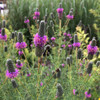Dalea purpurea - PURPLE PRAIRIE CLOVER
Purple prairie clover is a showy, native North American perennial. It grows in slender-looking, upright clumps, with fine leaves and cylindrical spikes of purple flowers.
Drought tolerant. This is a pollinator favorite plant - the pollen and nectar attract many kinds of insects. However, this plant is also rich in proteins, so it is eaten by mammals and deer, and can difficult to established in areas where these animals are overpopulated.
Very nice addition to rock gardens, borders, native plant gardens, wild gardens, pollinator gardens, honey bee plantings, prairies or naturalized areas. It looks best in soil that is not amended (with manure or lots of compost, for example) or overly rich in nutrients, as it can grow up to 3' tall and looses some proportional beauty, because the flowers look too small compared to the rest of the plant.
Picture copyright: US Perennials nursery
Blooming Time: June to August
Size: 1-1.5' tall and wide
USDA Zones: 3 to 8
Culture: full sun, average soils, preferably drained, rocky or shallow soils
Moisture Needs: average
Origin: native to most of North America, except the west and east coasts and the far north (USDA distribution map)
Deer/Rabbit Resistant: no / no
Attracts Butterflies or Pollinators: pollinator favorite! Honeybees, bumblebees, many other native bees (cuckoo bees, long-horned bees, leafcutter bees), Sphecid wasps, Tiphiid wasps, Syrphid flies, bee flies, thick-headed flies, small butterflies, skippers, and beetles. 4 species of plasterer bees are specialized for purple clover
Attracts Hummingbirds: no
Pot Size: square 3.5" x 4" deep perennial pot

Dalea purpurea - PURPLE PRAIRIE CLOVER
Purple prairie clover is a showy, native North American perennial. It grows in slender-looking, upright clumps, with fine leaves and cylindrical spikes of purple flowers.
Drought tolerant. This is a pollinator favorite plant - the pollen and nectar attract many kinds of insects. However, this plant is also rich in proteins, so it is eaten by mammals and deer, and can difficult to established in areas where these animals are overpopulated.
Very nice addition to rock gardens, borders, native plant gardens, wild gardens, pollinator gardens, honey bee plantings, prairies or naturalized areas. It looks best in soil that is not amended (with manure or lots of compost, for example) or overly rich in nutrients, as it can grow up to 3' tall and looses some proportional beauty, because the flowers look too small compared to the rest of the plant.
Picture copyright: US Perennials nursery
Blooming Time: June to August
Size: 1-1.5' tall and wide
USDA Zones: 3 to 8
Culture: full sun, average soils, preferably drained, rocky or shallow soils
Moisture Needs: average
Origin: native to most of North America, except the west and east coasts and the far north (USDA distribution map)
Deer/Rabbit Resistant: no / no
Attracts Butterflies or Pollinators: pollinator favorite! Honeybees, bumblebees, many other native bees (cuckoo bees, long-horned bees, leafcutter bees), Sphecid wasps, Tiphiid wasps, Syrphid flies, bee flies, thick-headed flies, small butterflies, skippers, and beetles. 4 species of plasterer bees are specialized for purple clover
Attracts Hummingbirds: no
Pot Size: square 3.5" x 4" deep perennial pot




